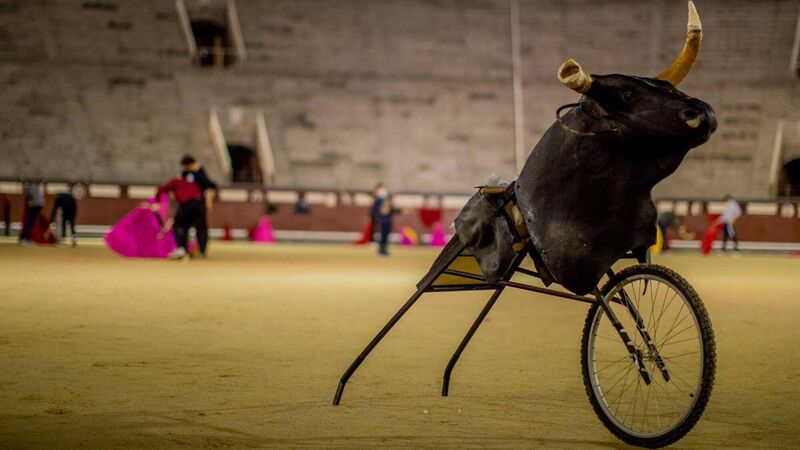The Last Dance: Can bullfighting recover from Covid?

Carreton' (bulls horns attached to a metal frame with wheels) is pictured as pupils practice at Las Ventas bullring in Madrid.
Their faces are fixed in concentration as they hone their craft. They are like youths in any academy of sport or the arts, full of hopes and dreams though fame beckons for only a small number.
But these youngsters are learning how to dance with death.
The kids, photographed by Associated Press last week, are students of the Bullfighting School at Las Ventas in Madrid. Las Ventas is Spain’s biggest bullring and one of its most prestigious – to learn the ancient art there is like learning ballet at the Bolshoi.
Children as young as nine practice the feints and movements of the matador, swishing the muleta while another trainee brandishes a set of plastic horns, imitating the deadly confrontation that lies ahead.
Though it is the maiming and killing of the animals that has long drawn controversy toward La Tauromaquia, there is risk for the matadors too. In 2016, Victor Barrio died after being gored through the chest live on television. According to Spanish newspaper El Pais, 33 matadors have been killed in Spain in the last century.

But for supporters of bullfighting the determined cadets are more than just the new breed learning their dangerous trade. They are a show of defiance.
Assailed by animal rights protests, the decline in the popularity of bullfighting in Spain has long seemed terminal. What was once a part of the nation’s cultural heritage is for many modern Spaniards an embarrassment, cruel and barbaric, an outdated symbol of patriarchy and machismo.
Attendances at corrida have fallen dramatically. In 2009 there were 2,684 bullfighting festivals held in Spain, according to government figures. A decade later, a combination of economic recession and public antipathy meant only 1,424 took place. Recent opinion polls show narrow majority in favour of banning the practice, with younger generations most hostile.
And then came Covid-19.
The pandemic wiped out the 2020 bullfighting season but its impact went beyond empty bullrings. An industry that claims to employ over 54,000 people and generate €1.5 billion each year was left without income, with the livelihoods of everyone from the strutting matadors to farm workers affected.
Thousands of the torro bravo bulls bred to fight were instead slaughtered for meat. The best of these would fetch up to €15,000 if sold for big events like the Feria de San Isidro at Las Ventas or Pamplona’s world famous festival. Without the income from bullfighting farmers were unable to pay for the upkeep of the animals.
Most galling was the refusal by the government to allow those employed in bullfighting to avail of income supports for those working in cultural sectors affected by the pandemic. Led by high-profile matadors, pro-bullfighting campaigners marched in protest in cities across Spain.
While bullfighting cried for help, opponents saw the pandemic as an opportunity for Spain to finally rid itself of the brutal spectacle. Spain was one of the worst affected countries – how could public money be used to prop up animal cruelty in an already heavily subsidised industry?
To enthusiasts, bullfighting is more like an art form than a sport. Matadors are praised for the style and technique of their passes, the skill and precision of the kill. Delight the crowds enough and you may be awarded trofeos – the ears and tail of the vanquished bull. The very best are carried shoulder high through the doors of the arena.
For admirers, the costumes and rituals of the corrida are of such deep cultural import as to be almost sacred. They talk about bullfighting in spiritual terms.
“For me, the corrida replicates the cycle of life. We are born, we live, and we die,” said leading matador Alberto López Simón in a 2017 interview.
“What fills the torero with pride and emotion is that the animal they are fighting has the chance to show its majesty, its strength, and bravery in front of thousands of people; it has the opportunity to create art. The bulls that live and die in farms do not have that chance.”

For opponents, such lofty language ignores the torture visited upon a tormented animal in the name of human entertainment. At its heart, this is like any culture war – one side’s deeply held convictions are the other side’s hypocrisy. We have this in Ireland with the debate over hare-coursing and greyhound racing: opponents who think about the issue in totally different terms, destined to remain in permanent conflict.
But the headwinds faced by bullfighting are political as much as moral. The decision by independence-seeking Catalonia to ban the practice in 2010 was about nationalism as much as animal rights, with bullfighting symbolic of right-wing, patrician centralism. In response to Catalonia’s move, the Spanish constitutional court ruled in 2016 that bullfighting was part of Spanish cultural heritage and should be protected.
Plans by the current left-wing government parties to legislate against animal cruelty have spooked the industry. “It makes me very uncomfortable,” said deputy prime minister Pablo Iglesias of the far-left Podemos party, “that something is promoted as a cultural practice that I cannot avoid seeing as delivering a lot of pain to an animal in a show for the enjoyment of people.”
The right-wing Vox party have, in turn, vowed to protect bullfighting.
It may not be a sport, but bullfighting is now a political football.
None of which matters much to the youngsters at Las Ventas. Closed from March to October last year, the eager pupils’ return is a boost to the embattled industry. “Considering that this world was already being hard-hit before (the pandemic), the excitement that the boys have brought back after the lockdown is incredible,” their teacher Miguel Rodríguez told AP.
Bullfighting has been here before, having survived the efforts of Romans, Arabs, Bourbon rulers and the mediaeval Catholic church to have it banned.
But supporters feel 2021 could be decisive if bullrings cannot be opened to the public.
Organisers of Seville’s annual spring festival have tentatively booked in an all-star bill for Easter Sunday.
Appropriately, it is being headlined “Resurrection.”












